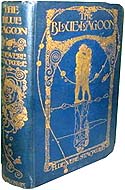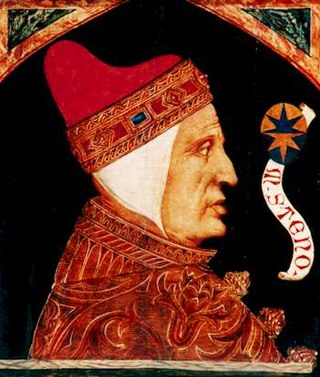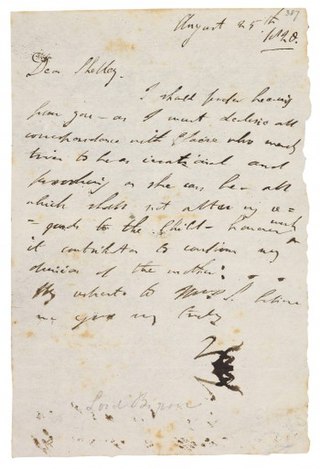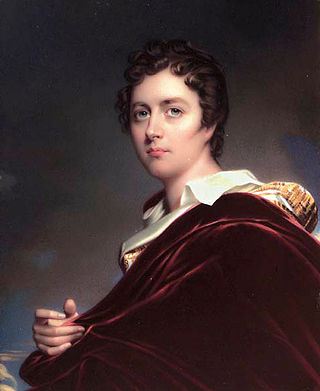
Francesco Foscari was the 65th Doge of the Republic of Venice from 1423 to 1457. His reign, the longest of all Doges in Venetian history, lasted 34 years, 6 months and 8 days, and coincided with the inception of the Italian Renaissance.

Sir Peter Courtney Quennell was an English biographer, literary historian, editor, essayist, poet, and critic. He wrote extensively on social history. In his Times obituary he was described as "the last genuine example of the English man of letters". Anthony Powell called him "The Last of the Mandarins".

Marino Faliero was the 55th Doge of Venice, appointed on 11 September 1354.

Jean-François Casimir Delavigne was a French poet and dramatist.

The Basilica dei Santi Giovanni e Paolo, known in Venetian as San Zanipolo, is a church in the Castello sestiere of Venice, Italy.

The Blue Lagoon is a coming-of-age romance novel written by Henry De Vere Stacpoole, first published by T. Fisher Unwin in 1908. The Blue Lagoon explores themes of love, childhood innocence, and the conflict between civilisation and the natural world. The book immerses the reader in a captivating and haunting setting through Stacpoole's vivid depictions of the island and its untamed splendour.
Events in the year 1826 in Art.

Marino Faliero is a tragedia lirica, or tragic opera, in three acts by Gaetano Donizetti. Giovanni Emanuele Bidera wrote the Italian libretto, with revisions by Agostino Ruffini, after Casimir Delavigne's play. It is inspired by Lord Byron's drama Marino Faliero (1820) and based on the life of Marino Faliero (c.1285-1355), the Venetian Doge.

Ordelafo Faliero de Doni was the 34th Doge of Venice.

George Gordon Byron, 6th Baron Byron was an English poet and peer. He was one of the leading figures of the Romantic movement, and is regarded as among the greatest of English poets. Among his best-known works are the lengthy narratives Don Juan and Childe Harold's Pilgrimage; many of his shorter lyrics in Hebrew Melodies also became popular.

Michele Steno was a Venetian statesman who served as the 63rd Doge of Venice from December 1, 1400, until his death. He is remembered as the ruler crucial for establishing the Domini di Terraferma, in the aftermath of the War of Padua.
This article presents a detailed timeline of the history of the Republic of Venice from its legendary foundation to its collapse under the efforts of Napoleon.

Filippo Calendario was an architect, a designer of the 14th century Doge's Palace, Venice. He was executed for treason.

The Two Foscari: An Historical Tragedy (1821) is a verse play in five acts by Lord Byron. The plot, set in Venice in the mid-15th century, is loosely based on the true story of the downfall of doge Francesco Foscari and his son Jacopo. Byron's play formed the basis of Verdi's opera I due Foscari.

Sardanapalus (1821) is a historical tragedy in blank verse by Lord Byron, set in ancient Nineveh and recounting the fall of the Assyrian monarchy and its supposed last king. It draws its story mainly from the Historical Library of Diodorus Siculus and from William Mitford's History of Greece. Byron wrote the play during his stay in Ravenna, and dedicated it to Goethe. It has had an extensive influence on European culture, inspiring a painting by Delacroix and musical works by Berlioz, Liszt and Ravel, among others.
The Faliero coup was a failed 1355 coup designed to overthrow Venice's established republican government. Strains between the Venetian commoners and the nobility, originally stemming from the catastrophic failure of the nobility in the Battle of Porto-Longo against Venice's long-time rival, Genoa, are largely considered to be the main cause for the coup. However, traditional stories also point to the marriage of Doge Marino Faliero as a possible cause for the coup. Faliero, an 81 year old man, had recently taken a young bride, who was rumored to be engaged in multiple affairs, including with Michele Steno, a Venetian statesman and future Doge. The consistent rumors and apparent intense arrogance of the established Venetian elite seems to have gotten to Faliero in this explanation for a coup. A more reasonable one, however, is that Faliero wished to transform Venice into a dictatorship, mirroring those of Genoa and other northern Italian city-states. This view is, however, disputed by some historians, who cite Faliero's apparent regret at his trial, and, his lack of mentioning his belief that a dictatorship would better suit Venice's interests, a valid argument. These two actions are much more consistent with a man regretting a passionate crime, than one who had executed a calculated plan, some argue. The coup was poorly organized and abortive.

The letters of Lord Byron, of which about 3,000 are known, range in date from 1798, when Byron was 10 years old, to 9 April 1824, a few days before he died. They have long received extraordinary critical praise for their wit, spontaneity and sincerity. Many rate Byron as the greatest letter-writer in English literature, and consider his letters comparable or superior to his poems as literary achievements. They have also been called "one of the three great informal autobiographies in English", alongside the diaries of Samuel Pepys and James Boswell. Their literary value is reflected in the huge prices collectors will pay for them; in 2009 a sequence of 15 letters to his friend Francis Hodgson was sold at auction for almost £280,000.

Byron's Memoirs, written between 1818 and 1821 but never published and destroyed soon after his death, recounted at full-length his life, loves and opinions. He gave the manuscript to the poet Thomas Moore, who in turn sold it to John Murray with the intention that it should eventually be published. On Lord Byron's death in 1824, Moore, Murray, John Cam Hobhouse, and other friends who were concerned for his reputation gathered together and burned the original manuscript and the only known copy of it, in what has been called the greatest literary crime in history.

The Execution of the Doge Marino Faliero is an oil painting on canvas of 1826 by the French Romantic artist Eugène Delacroix, inspired by the 1821 play Marino Faliero, Doge of Venice by Lord Byron, which in turn was based upon events in the life of the Venetian Doge Marino Faliero (1274–1355). Today the work is part of the Wallace Collection in London; as of 2021 it is listed as "not on display".
Pietro Badoer was a Venetian patrician who served as duke of Crete in 1358–1360. His career was derailed by his closeness to the disgraced Doge Marino Faliero and he was banished twice, the second time for poisoning his wife.

















